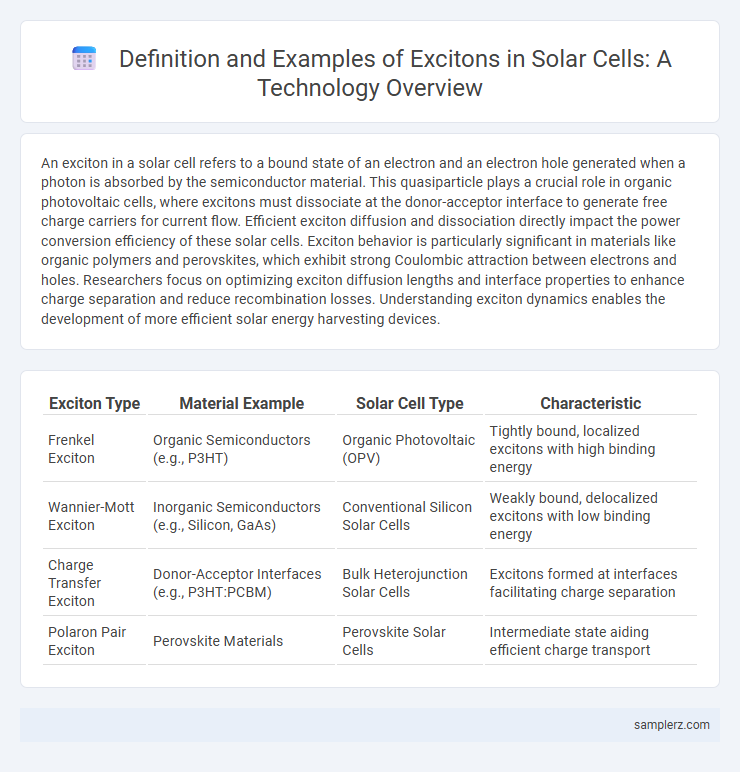An exciton in a solar cell refers to a bound state of an electron and an electron hole generated when a photon is absorbed by the semiconductor material. This quasiparticle plays a crucial role in organic photovoltaic cells, where excitons must dissociate at the donor-acceptor interface to generate free charge carriers for current flow. Efficient exciton diffusion and dissociation directly impact the power conversion efficiency of these solar cells. Exciton behavior is particularly significant in materials like organic polymers and perovskites, which exhibit strong Coulombic attraction between electrons and holes. Researchers focus on optimizing exciton diffusion lengths and interface properties to enhance charge separation and reduce recombination losses. Understanding exciton dynamics enables the development of more efficient solar energy harvesting devices.
Table of Comparison
| Exciton Type | Material Example | Solar Cell Type | Characteristic |
|---|---|---|---|
| Frenkel Exciton | Organic Semiconductors (e.g., P3HT) | Organic Photovoltaic (OPV) | Tightly bound, localized excitons with high binding energy |
| Wannier-Mott Exciton | Inorganic Semiconductors (e.g., Silicon, GaAs) | Conventional Silicon Solar Cells | Weakly bound, delocalized excitons with low binding energy |
| Charge Transfer Exciton | Donor-Acceptor Interfaces (e.g., P3HT:PCBM) | Bulk Heterojunction Solar Cells | Excitons formed at interfaces facilitating charge separation |
| Polaron Pair Exciton | Perovskite Materials | Perovskite Solar Cells | Intermediate state aiding efficient charge transport |
Introduction to Excitons in Solar Cells
Excitons in solar cells are bound electron-hole pairs generated when semiconductor materials absorb photons. These quasi-particles play a crucial role in organic and hybrid solar cells by facilitating the separation of charge carriers at donor-acceptor interfaces. Efficient exciton diffusion and dissociation directly impact the power conversion efficiency of photovoltaic devices.
Types of Excitonic Solar Cells
Types of excitonic solar cells include organic photovoltaic (OPV) cells, dye-sensitized solar cells (DSSCs), and quantum dot solar cells, each utilizing excitons to enhance light absorption and charge separation. OPV cells rely on conjugated polymers to generate excitons, while DSSCs use photosensitive dyes to create excitonic states at the dye-semiconductor interface. Quantum dot solar cells harness semiconductor nanocrystals to produce excitons with size-tunable energy levels, improving solar energy conversion efficiency.
Mechanism of Exciton Generation
In solar cells, exciton generation occurs when photons with energy greater than the semiconductor bandgap are absorbed, creating bound electron-hole pairs. These excitons, particularly in organic photovoltaic materials, migrate to the donor-acceptor interface where charge separation takes place. The efficiency of exciton diffusion and dissociation directly impacts the device's power conversion efficiency and overall performance.
Organic Photovoltaics: Exciton Dynamics
Organic photovoltaics rely on exciton dynamics where bound electron-hole pairs, or excitons, generated by light absorption diffuse to the donor-acceptor interface before dissociating into free charge carriers. Typical exciton diffusion lengths in organic materials range from 10 to 20 nm, influencing the optimal thickness of the active layer for efficient charge separation. Innovations in molecular design and interface engineering enhance exciton dissociation efficiency, improving power conversion efficiency in organic solar cells.
Perovskite Solar Cells and Exciton Behavior
Perovskite solar cells exhibit efficient exciton generation and dissociation due to their unique crystal structure and high dielectric constant, which facilitates charge separation. Excitons in these materials typically have low binding energy, enabling rapid conversion into free carriers for enhanced photovoltaic performance. Understanding exciton dynamics in perovskite layers is critical for optimizing light absorption and improving overall solar cell efficiency.
Quantum Dot Solar Cells: Exciton Applications
Quantum dot solar cells utilize excitons to enhance light absorption and charge separation efficiency. When photons strike the quantum dots, electron-hole pairs (excitons) are generated, which are then dissociated at interfaces to produce free charge carriers. This exciton management improves the power conversion efficiency and enables tunable absorption spectra in quantum dot photovoltaics.
Exciton Diffusion in Solar Cell Materials
Exciton diffusion in solar cell materials plays a crucial role in the efficiency of organic photovoltaic devices by enabling the migration of bound electron-hole pairs towards the donor-acceptor interface for charge separation. Materials such as conjugated polymers and small molecules exhibit exciton diffusion lengths typically ranging from 5 to 20 nanometers, directly impacting the design of active layers in bulk heterojunction solar cells. Enhancing exciton diffusion through molecular engineering and nanostructuring improves charge extraction, thereby increasing the overall power conversion efficiency of solar cells.
Role of Exciton Binding Energy
Exciton binding energy in solar cells determines the efficiency of charge separation by influencing how easily excitons dissociate into free charge carriers. Materials with lower exciton binding energies, such as organic photovoltaic polymers or perovskites, exhibit enhanced exciton dissociation, leading to higher photocurrent generation. Optimizing exciton binding energy improves the overall power conversion efficiency by facilitating effective charge transport and reducing recombination losses.
Strategies for Exciton Dissociation Enhancement
Strategies for exciton dissociation enhancement in solar cells include the integration of optimized donor-acceptor heterojunctions that facilitate efficient charge separation. Incorporating nanostructured materials such as quantum dots or graphene can increase the exciton dissociation rate by expanding the interface area and promoting rapid charge transfer. Tailoring molecular energy levels through chemical engineering further improves exciton splitting efficiency, boosting overall photovoltaic performance.
Future Trends in Exciton-Based Solar Technologies
Exciton-based solar technologies are advancing with the integration of perovskite and organic photovoltaic materials, which enhance exciton generation and charge separation efficiency. Emerging developments in 2D materials, such as transition metal dichalcogenides (TMDs), show potential for improved exciton diffusion lengths and novel light-harvesting mechanisms. Quantum dot solar cells are also being explored for their tunable excitonic properties, enabling higher power conversion efficiencies in next-generation solar devices.

example of exciton in solar cell Infographic
 samplerz.com
samplerz.com